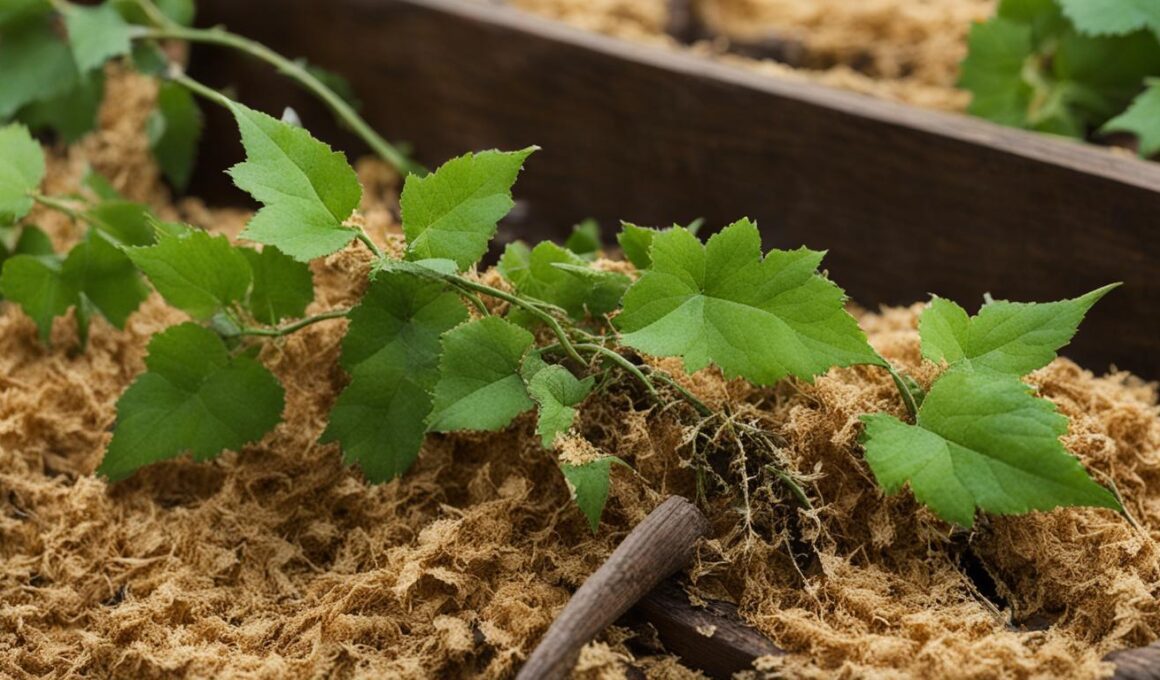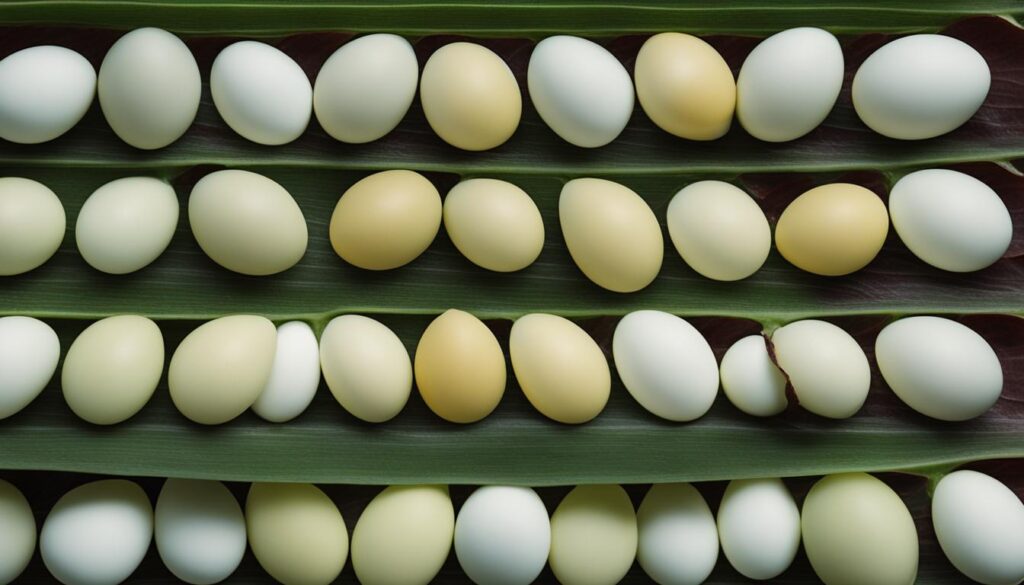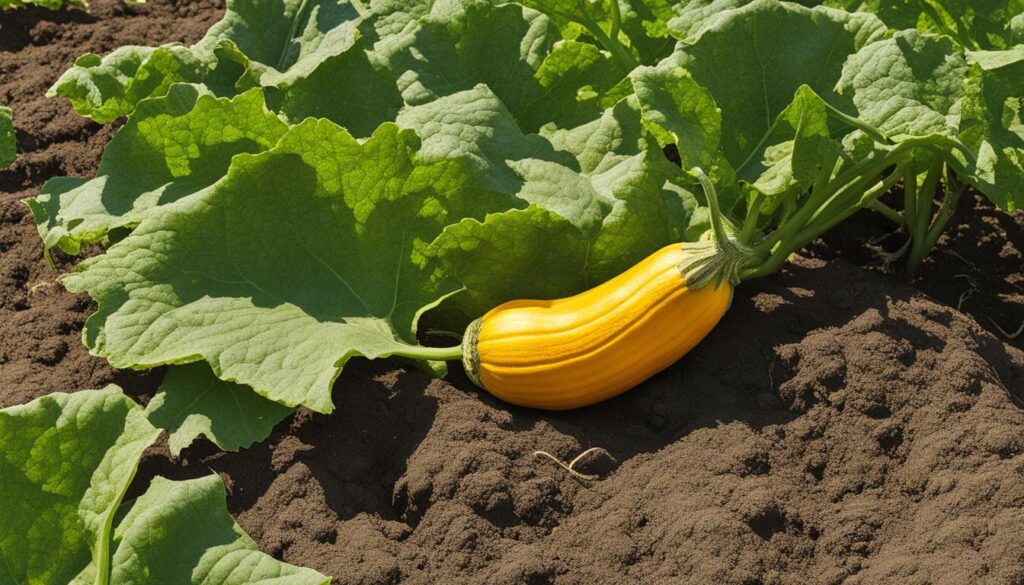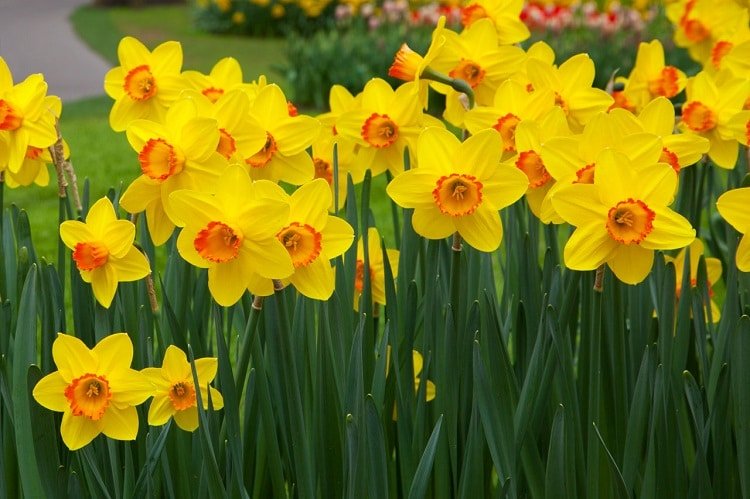Welcome to our comprehensive guide on identifying the signs of vine borer infestation, an all too common issue that can wreak havoc on your squash plants. In this article, we will delve into the world of vine borers, learning how to recognize their presence, understand their life cycle, and explore strategies for prevention and control. By arming yourself with knowledge and taking proactive measures, you can safeguard your precious plants from the devastating effects of vine borer damage.
Key Takeaways:
- Early detection is crucial in preventing extensive damage from vine borers.
- Common signs of vine borer infestation include wilting, small holes, and sawdust-like frass.
- Understanding the life cycle of vine borers can aid in developing effective control strategies.
- Preventive measures such as prompt removal of spent vines and creating barriers can minimize the risk of infestations.
- Control methods for vine borers include hand removal, puncturing stems, and organic pesticides.
Understanding the Life Cycle of Vine Borers
The life cycle of a vine borer is a fascinating process that plays a crucial role in their ability to infest and damage squash plants. By understanding their life cycle, you can develop effective strategies to control and prevent infestations.
It all begins with the moth, which lays its eggs on the leaves of squash plants. These eggs are small and often go unnoticed. After a period of time, usually within a week, the eggs hatch into larvae. These larvae, also known as squash vine borer larvae, are the most destructive stage of the vine borer’s life cycle.
Once hatched, the larvae bore into the stem of the plant and begin feeding on the plant from the inside. This feeding causes the plant to wilt and can eventually lead to its death. The larvae continue to grow and feed inside the stem, gradually causing more damage as they progress. After a period of feeding, the larvae pupate in the soil, forming a protective cocoon-like structure called a pupa. Within this pupa, the transformation from larva to adult moth takes place.
Finally, after a period of time, the adult moth emerges from the pupa and starts the cycle all over again by laying its eggs on squash leaves. This continuous life cycle ensures the survival and propagation of vine borers, making them a persistent threat to squash plants.
Vine Borer Life Cycle Summary:
- Moth lays eggs on squash leaves
- Eggs hatch into squash vine borer larvae
- Larvae bore into the stem and feed on the plant
- Larvae pupate in the soil
- Adult moth emerges and lays eggs, starting the cycle again
| Stage | Description |
|---|---|
| Egg | Small, laid on squash leaves by the moth |
| Larva | Hatches from the egg and bores into the stem, feeding on the plant |
| Pupa | Formed when the larva pupates in the soil, transforming into an adult |
| Adult Moth | Emerges from the pupa and starts the cycle again by laying eggs |
Preventing Vine Borer Infestations
Preventing vine borer infestations is crucial in safeguarding your squash plants. By implementing a few preventive measures, you can significantly reduce the risk of these destructive pests attacking your crops. Here are some effective methods to consider:
1. Remove Spent Vines Immediately:
After harvesting, it’s important to remove spent vines from your garden as soon as possible. Vine borers can lay their eggs on these leftover vines, allowing them to overwinter and reinfest your plants in the following season. By disposing of the vines promptly, you eliminate any potential hiding spots for vine borers.
2. Till the Soil:
Tilling the soil around your squash plants can help expose any vine borer larvae that may be lurking beneath the surface. Birds, such as robins and blue jays, are natural predators of these larvae and will feast on them when brought to the surface. By encouraging birds to your garden, you can help keep the vine borer population in check.
3. Plant Squash Later:
Consider planting your squash a bit later in the season to mitigate the risk of vine borer infestations. Vine borers are most active during the early part of the growing season, so delaying the planting can reduce the chances of your plants being targeted. This strategy can be particularly effective in regions with a shorter growing season.
4. Monitor and Remove Eggs:
Regular inspection of your squash plants is essential in detecting vine borer eggs before they hatch. These small, bright orange eggs can often be found on the underside of squash leaves. By removing the eggs as soon as you spot them, you can prevent the larvae from boring into the stems and causing damage.
By following these preventive measures, you can create a less favorable environment for vine borers and protect your squash plants from infestations. Staying vigilant and implementing these strategies will go a long way in preserving the health and productivity of your garden.
Identifying Vine Borers Early
Early identification of vine borers is essential in preventing extensive damage to your squash plants. By recognizing the telltale signs of an infestation, you can take prompt action and protect your plants from further harm. Two key indicators to look out for are vine borer eggs and evidence of a borer infestation.
Identifying Vine Borer Eggs
Vine borer eggs are small and bright orange, typically found on the underside of squash leaves. Carefully inspect the leaves of your plants, paying close attention to the lower surface. Look for clusters of tiny, oval-shaped eggs attached to the leaf veins. If you spot any, it’s a clear indication that vine borers are present in your garden.
Detecting Vine Borer Infestation
In addition to identifying the eggs, checking the base of your squash plants can help you detect a vine borer infestation. Look for small holes in the stem, often surrounded by sawdust-like frass. These holes are created by the borer larvae as they bore into the plant. If you notice these signs, it’s crucial to take immediate action to prevent further damage.
Regular inspection and monitoring are key to catching vine borers early. By staying vigilant and actively searching for signs of infestation, you can intervene before the borers cause irreparable harm to your plants. Remember to check your plants regularly, especially during the peak vine borer season.
Table: Signs of Vine Borer Infestation
| Signs | Description |
|---|---|
| Wilting of plants | Sudden wilting of squash plants is a common symptom of vine borer infestation. The larvae bore into the stem, disrupting the plant’s vascular system, and causing it to wilt. |
| Small holes in stem | Vine borers create small entry holes in the stem of squash plants as they bore inside. Look for these holes near the base or lower stem of the plant. |
| Sawdust-like frass | As the borers feed on the plant tissue, they produce sawdust-like waste known as frass. It can often be found around the base or lower stem of the plant. |
| Vine borer eggs | The eggs of vine borers are small and bright orange. They are typically laid on the underside of squash leaves, near the veins. |
By familiarizing yourself with the signs of vine borer infestation and regularly inspecting your plants, you can identify vine borers early and take appropriate action. Remember to remove any eggs you find and employ preventive measures to protect your squash plants from these damaging pests.
Control Methods for Vine Borers
Once a vine borer infestation is confirmed, it is essential to take immediate action to minimize further damage to your plants. There are several control methods that you can employ to effectively manage vine borers and protect your squash plants.
Removing Vine Borer Larvae
One method of controlling vine borers is to physically remove the larvae from the affected plants. If the infestation is caught early, and the plant is still healthy, you can carefully cut open the stem and remove the larvae by hand. Be sure to bury the damaged part of the vine to prevent reinfestation. This method may help save the plant and prevent the spread of vine borers.
Organic Pest Control for Vine Borers
Organic pesticides can also be effective in controlling vine borers. One popular option is Bacterial Thurengensis, a naturally occurring bacteria that targets and kills the larvae of certain pests, including vine borers. However, it’s important to note that the effectiveness of organic pesticides can vary, and it may be necessary to reapply them throughout the growing season.
Creating a Physical Barrier
Another preventive measure is to create a physical barrier around the base of your squash plants to prevent vine borer attacks. You can use aluminum foil or gauze strips to wrap around the stem, making it difficult for the adult moths to lay their eggs on the plant. This method can be particularly effective when combined with regular monitoring and removal of any eggs or larvae that may still make their way onto the plant.
| Control Method | Effectiveness | Notes |
|---|---|---|
| Removing Vine Borer Larvae | Moderate | Effective if caught early and plant is healthy. |
| Organic Pest Control (Bacterial Thurengensis) | Varies | May require reapplication and effectiveness can vary. |
| Creating a Physical Barrier | Moderate | Effective when combined with other preventive measures. |
It’s important to note that pesticides are generally not effective once the vine borer larvae have burrowed inside the stem. Therefore, early detection and prompt action are crucial in controlling vine borers and minimizing damage to your squash plants.
Additional Tips for Dealing with Vine Borers
Vine borers can be a persistent challenge for squash plants, but with the right strategies, you can effectively deal with the damage they cause and protect your plants. Here are some additional tips to help you manage vine borers:
1. Trim Affected Stems
If you notice wilting or damage caused by vine borers, you can try cutting open the affected stem to locate and remove the borer. Make a vertical incision along the stem until you find the borer, then carefully remove it using tweezers or a small knife. After removing the borer, bury the damaged portion of the vine to promote healing and prevent further infestation.
2. Crop Rotation and Companion Planting
Implementing crop rotation practices can help disrupt the life cycle of vine borers. Avoid planting squash in the same location year after year, as this can create an ideal environment for the pests to thrive. Instead, rotate your crops by planting squash in different areas of your garden each season. Additionally, consider companion planting with pest-repellent herbs and flowers, such as marigolds, to deter vine borers and other pests.
3. Good Garden Maintenance
Proper garden maintenance plays a crucial role in preventing and managing vine borer infestations. At the end of the growing season, clean up your garden by removing any plant debris or spent vines. Destroy any infected plants to eliminate potential overwintering sites for vine borers. By maintaining a clean and healthy garden environment, you can significantly reduce the risk of future infestations.
By following these additional tips, you can enhance your efforts in dealing with vine borer damage and protecting your precious squash plants. Remember to stay vigilant and take prompt action at the first signs of infestation to minimize the impact on your garden. With proper care and management, you can enjoy a successful harvest free from the interference of vine borers.
The Importance of Squash Vine Borer Prevention
Preventing vine borer infestations is of utmost importance when it comes to safeguarding the health and productivity of your squash plants. These destructive pests have the potential to cause severe damage and even death to your plants if left untreated. By implementing effective preventive measures and staying vigilant, you can protect your beloved squash plants from vine borer attacks and ensure a successful harvest.
Vine borers, in their larval stage, bore into the stem of squash plants, causing wilting and irreversible damage. Once inside the stem, they are protected from most conventional control methods. That’s why early detection is crucial. By regularly inspecting the base of your plants and checking for small holes and sawdust-like frass, you can identify a vine borer infestation at its early stages and take immediate action.
Preventing vine borer infestations saves your squash plants from extensive damage and potential loss. By following preventive practices such as removing spent vines after harvest, tilling the soil to expose borers to natural predators, and creating physical barriers around the stem, you can significantly reduce the risk of an infestation. Additionally, planting multiple crops and rotating squash plants each season helps manage vine borer populations and ensures the long-term health of your garden.
By prioritizing the prevention of vine borers, you can enjoy a flourishing garden filled with healthy squash plants, abundant harvests, and the satisfaction of successfully protecting your plants from these notorious pests.
The Importance of Squash Vine Borer Prevention:
- Protects the health and productivity of squash plants
- Prevents severe damage and potential loss
- Ensures early detection and prompt action
- Saves your plants from irreversible harm
- Reduces the risk of future infestations
- Contributes to a flourishing and bountiful garden
Implementing preventive measures against vine borers not only saves your squash plants from direct damage but also promotes a healthier garden ecosystem. By minimizing the use of pesticides and relying on natural control methods, you can create a more sustainable and environmentally friendly garden. So, don’t underestimate the importance of vine borer prevention – it’s a crucial step toward a thriving garden and successful squash harvests.
Do Vine Borers Have an Aversion to Certain Plants, Including Bee Repellent Flora?
Yes, vine borers do have an aversion to certain plants, including bee repellent plants for bees. These types of plants naturally repel bees, making them an unattractive option for vine borers looking for a place to lay their eggs. Planting bee repellent flora can help protect your garden from these destructive pests.
Conclusion
Squash vine borers can pose a significant threat to your garden’s squash plants. However, by implementing effective vine borer prevention measures and employing suitable control methods, you can protect your plants and ensure a healthy and productive harvest.
It is crucial to learn how to identify the telltale signs of vine borer infestation, such as wilting plants, small holes, and sawdust-like frass around the base or lower stem. By detecting these signs early, you can take immediate action to prevent further damage.
Remember to prioritize squash plant protection by implementing preventive measures like removing spent vines, tilling the soil, and creating a barrier around the stem. Regular monitoring and timely removal of vine borer eggs and larvae are also essential in controlling their population.
With your vigilance and the right strategies in place, you can effectively manage vine borer infestations and safeguard your squash plants. By doing so, you will ensure a thriving garden and a successful harvest, free from the interference of these damaging pests.
FAQ
What are the signs of a vine borer infestation?
The signs of a vine borer infestation include sudden wilting of squash plants, small holes and sawdust-like frass around the base or lower stem of the plant.
How can I identify vine borer eggs?
Vine borer eggs are small and bright orange, often found on the underside of squash leaves.
What preventive measures can I take to minimize vine borer infestations?
Some preventive measures include removing spent vines immediately after harvesting, tilling the soil to bring borers to the surface, planting squash later in the season, monitoring for and removing eggs, and using foil or gauze strips as a barrier.
What should I do if I find vine borer larvae in my plants?
If caught early and the plant is healthy, you can try removing the vine borer larvae by hand or puncturing the stem with a needle. Organic pesticides like Bacterial Thurengensis can also be used, but their effectiveness may vary.
How can I deal with vine borer damage?
Cutting open the affected stem to remove the borer and burying the damaged part of the vine can sometimes save the plant. Planting multiple crops and rotating squash plants each season can also help in managing vine borer populations.
Why is preventing vine borer infestations important?
Preventing vine borer infestations is crucial to ensure the health and productivity of your squash plants. These pests can cause severe damage and even death to plants if left untreated.











